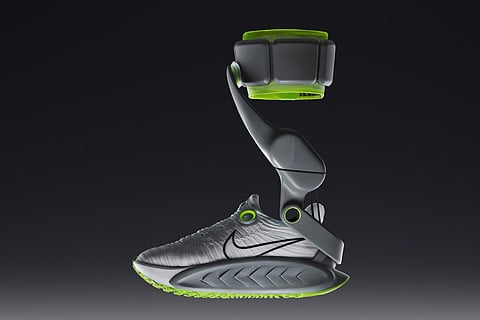Nike’s Project Amplify: The robotic sneaker that turns your feet into e-bikes
New motorised footwear system gives everyday runners a powered boost to move farther

In October 2025, Nike pulled back the curtain on a bold new chapter in its innovation story: Project Amplify, described as “the world’s first powered footwear system for running and walking.” This is not merely a flashy sneaker drop—it is a radical proposition: what if your shoes could help you move, instead of just accommodating you?
The tech behind the swoosh
Developed in collaboration with robotics firm Dephy, the system fuses a lightweight motor and drive-belt mechanism with a rechargeable cuff battery that sits at the ankle—and all of it integrates into a carbon-plated running shoe that can still be worn without the assistive tech. According to Nike, the goal is to “augment natural lower leg and ankle movement,” effectively giving everyday athletes “a second set of calf muscles.”
In practical terms, Nike’s internal testing—over 400 athletes and more than 2.4 million steps worth of data—suggests that some users found their typical 12-minute mile pace improve to 10 minutes while using the device. That kind of assistive boost may not appeal to elite marathoners chasing seconds off their PRs—but that appears entirely by design.
A shift in target audience
Nike is positioning Project Amplify not for competitive elites, but for the “everyday athlete.” In other words: those who walk, jog or run at a more modest 10–12-minute mile pace, or simply are seeking to move more with less strain. In doing so, Nike is extending its long-running mantra— “If you have a body, you are an athlete” —into the realm of assistive movement and wearable robotics.
One reviewer, describing the experience, said it felt like “a second set of calf muscles” and likened the motion to an e-bike for your feet. For many, the uphill climb felt like flat ground. The message here: movement can be more fun, more accessible, less punishing.
Innovation strategy & market context
This move also arrives at a critical moment for Nike. The company has faced headwinds—sales slowdowns, market share pressure from nimble competitors, and questions about whether its innovation pipeline still leads the industry. By unveiling something as radical as Project Amplify, Nike sends a signal: it still means to lead on tech, not just branding.
The launch is part of a broader 'innovation engine' initiative, pairing Project Amplify with other developments including advanced cooling apparel, neuroscience-based footwear and high-tech knit materials. The implication: this is about more than one sneaker—it’s about redefining what movement means.
Challenges Ahead
Of course, there are immediate questions. The technology remains in testing. Nike itself states the system is 'in the early stages' and a broad consumer launch is still years away. Practical concerns also loom: battery life, weight, cost, durability, and whether everyday users will embrace the visual and functional complexity of a 'motorised shoe.' Some early testers noted a slight 'learning curve' and a feel that it still isn’t yet seamless.
There’s also the question of market positioning. Who ultimately pays for this assist? Is it the fitness-enthusiast who wants more of a boost, or the mobility-challenged who could benefit from assistive technology? Nike’s framing leans toward broad inclusion, but business models will follow.
Why it matters
In many ways, Project Amplify is emblematic of a shift in sport and technology: from passive equipment (shoes, apparel) toward active systems that augment or enable human movement. When Nike says the product 'breaks the perception of possibility,' it isn’t marketing hyperbole—it is staking a claim in a future where wearable robotics may become part of everyday movement.
For consumers, this means a potential impact beyond sport. Imagine walking commutes that feel easier, uphill hikes that feel flatter, jogs that feel more manageable—and all because your shoes are doing something. It’s not just performance—it’s accessibility, longevity, fun.
Looking ahead
What’s next? Nike still needs to refine the hardware, software, usability and aesthetics. According to the brand, more than nine distinct prototypes have been built to date and countless iterations tested. Cosmetic form-factor and user comfort will matter if this moves beyond niche early adopters.
The company hasn’t confirmed price or release date—public reports suggest a launch “in the coming years” but no specifics.
From a broader perspective, however, the significance is clear: Nike is again playing at the frontier of movement innovation. If Project Amplify succeeds, the next “swoosh” might come with a little whirr of a motor.
Sign up for the Daily Briefing
Get the latest news and updates straight to your inbox







